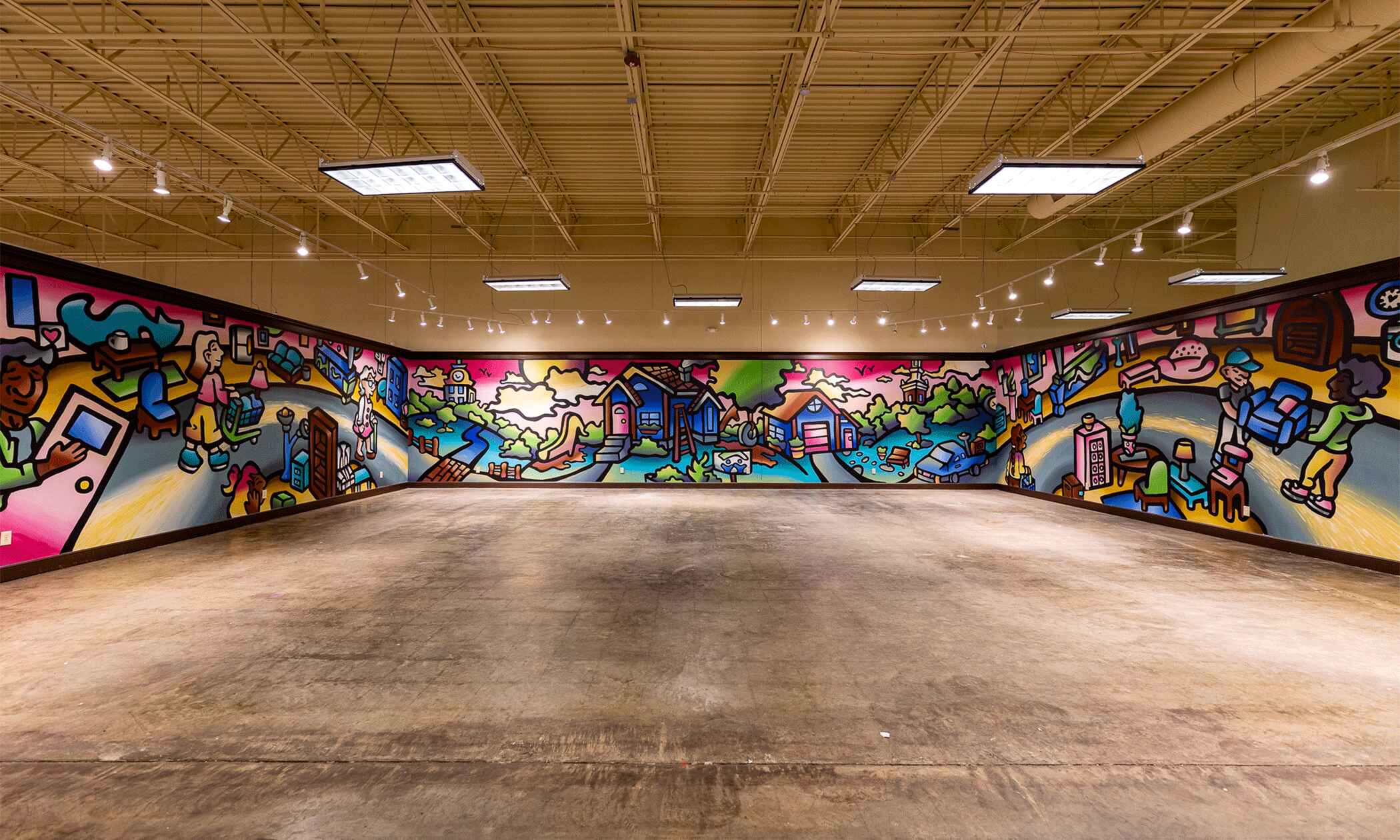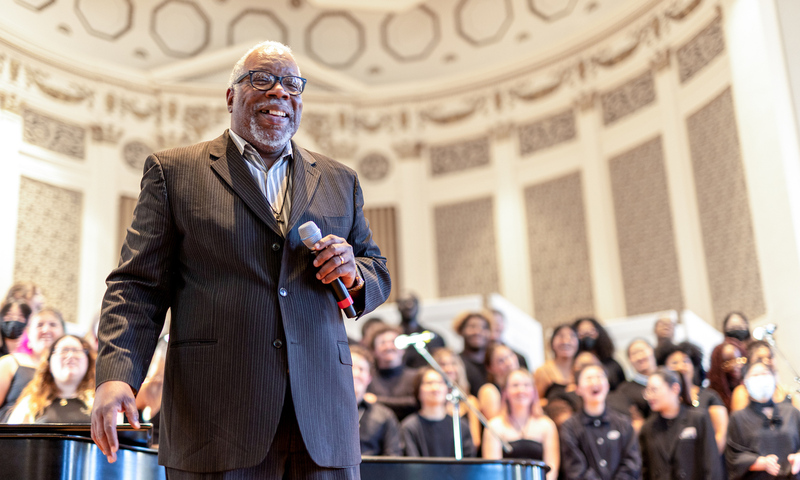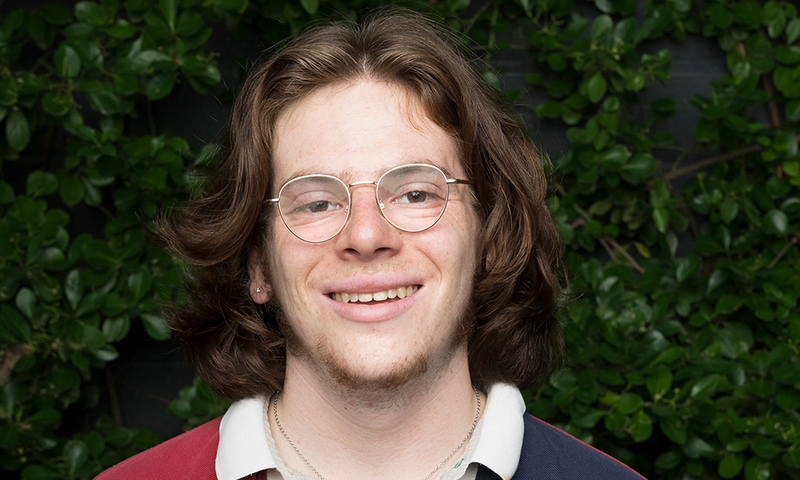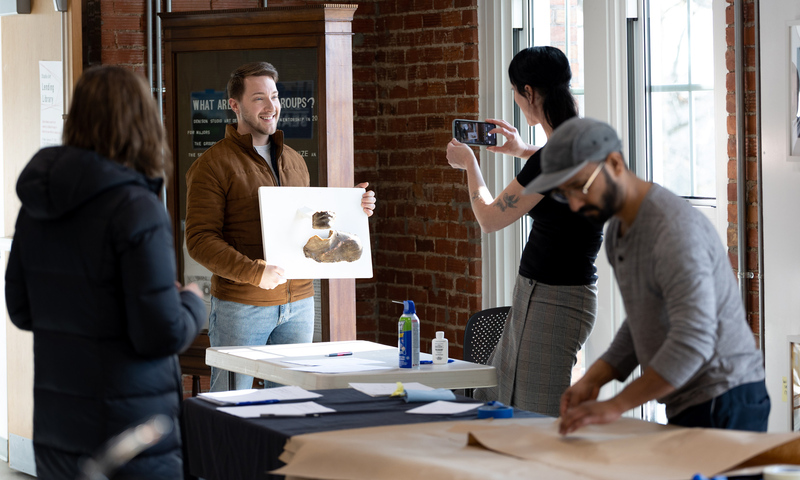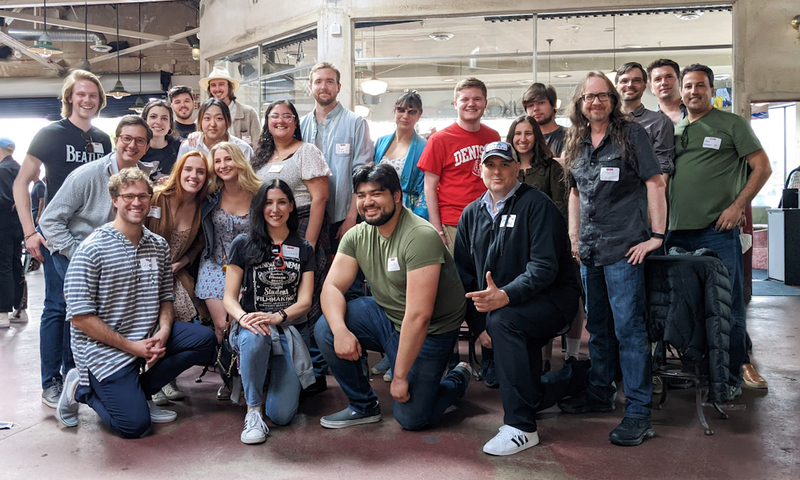Mel Wienandt ’26 stands before the blank walls, taking in all 981 square feet.
The Newark commercial space she finds herself in — formerly a FrontRoom Furnishings — is not exactly empty. Scattered throughout the cavernous space are kitchen cabinets and dining room tables and boxes upon boxes of donated goods, from treadmills to silk pajamas.
This is the future home of a Habitat for Humanity ReStore, and on this afternoon in January 2023, the overall vibe is sterile and decidedly colorless. Think industrial gray, not feng shui.
The task ahead for Wienandt, a first-year studio art student at Denison, is to fill three walls here with color, meaning, and life. She will paint a mural for Habitat for Humanity as part of Denison’s Summer Scholars program.
Equipped with her artistic vision, the guidance of studio art associate professor Keith Spencer, and over 20 gallons of paint, she hopes to capture the joy and pride borne of Habitat’s mission: putting families into safe, affordable houses.
“They’re first-time homebuyers, and many of them thought they would never own a home,” Habitat for Humanity-MidOhio President & CEO E.J. Thomas says as he and other Habitat officials show Wienandt the space.
They look at examples of Wienandt’s work and are impressed. Her art is bold and eye-catching, with overtones of street graffiti and the sequential art found in serial comics like Kazu Kibuishi’s “Amulet” and Robert Kirkman’s “The Walking Dead.”
Thomas smiles as their first meeting wraps up.
“Mel has not run screaming out the door,” he says. “So, good first step.”
“I’m excited,” she says.
The finish line is months away. The white space in front of her feels vast, and on this first visit, Wienandt has only an inkling of just how big the undertaking will turn out to be.
Freedom and exploration
Four months later, she’s starting to get an idea.
Denison is on summer break. On 21st Street in Newark, the ReStore is open for business.
As a Summer Scholar, Wienandt has been given her studio space in the Bryant Arts Center.
“Keep a routine even if you don’t feel inspired,” Spencer tells her.
Already she has personalized it with her own art, an idea board for the mural covered with notes and a mock-up of her latest plan, and smaller projects that she will use as motivation whenever she feels her energy flagging for the big project.
“When I’m in the brainstorming stage, I like to throw everything into one spot so I can see it,” she says. “That’s a visual overload for most people.”
The Summer Scholars program gives Denison students in all disciplines a chance to experiment with their intellectual ideas and artistic expression, free from the pressures of grades. Endowed funds support 120 to 140 students pursuing research or other projects under faculty supervision each summer.
Wienandt’s project was made possible by the Mary G. and G. Harold Osborne Fine Arts Opportunity Fund, which was created through the generous philanthropy of Dr. William N. Osborne, Distinguished Professor of Fine Arts Emeritus at Denison.
The program places significant responsibility on students; there is no hand-holding. For Wienandt, painting is only part of the project. She is also responsible for logistics: planning, coordinating with volunteers, and communicating with Habitat for Humanity leaders. It’s a lot to take on, but she relishes the responsibility and trust placed in her.
‘A full and present person’
Much of this is new to her. Wienandt’s interest in art developed in high school in Neenah, Wisconsin. She was an excellent all-around student but quiet and anxious; the attention of her teachers often fell upon other students. She stresses that she understands her role in being overlooked; she was never one to speak out in class or make herself known.
That was true in art class, too, where she suspects her high school teacher saw her “as a good person more than an artist.” And yet the artist who felt largely unnoticed, and who was adept at hiding in plain sight, finished high school with some 600 completed artworks in her portfolio.
“No one really believed in me,” she says. “And I’m really hard on myself. It was just hard to be that full, present person.”
That has changed at Denison.
Her initial plan had been to attend an East Coast art school. She didn’t get in, which she now thinks was a good thing. She suspects she might have been pushed to become a certain type of artist there, namely someone she isn’t.
“I probably wouldn’t have been able to explore my style that much,” she says. “I’m really independent, and I don’t like being restrained as an artist in any capacity.”
She also realized she wanted a more well-rounded education, and that suits her at a liberal arts college like Denison. She always enjoyed learning multiple subjects. By the end of her first year in college, her professors were not only noticing her in class but urging her to consider their disciplines as a major.
But she’s sticking with her plan to receive a BFA in studio art, with possible minors in anthropology/sociology or creative writing. She committed herself to speaking in class daily, and she finds the feedback of professors like Spencer — sometimes tough, but always honest — a refreshing change from high school.
From monochrome to technicolor
The summer ticks by. First, she uses a projector to trace the skeleton of her design in black paint. The side walls depict the shoppers at ReStore, their purchases helping to pay for Habitat’s construction of new homes. That is the focal point of the center wall, a new home for someone, nestled among the hills between Granville and Newark. Careful observers will spy the Licking County Courthouse, Denison’s Swasey Chapel, and Granville’s downtown clock.
Volunteers help Wienandt fill in the white spaces with base colors. She handles the nuance herself: the shading, the highlights, the precise detailing. ReStore customers wander past and occasionally stop to watch her work, sometimes seated on the floor, sometimes atop a 12-foot stepladder.
Gradually the space transforms from monochrome to technicolor.
The finished piece is still weeks off, but she is happy with her progress.
“This is a project I’ve always wanted,” she says. “It took a lot to get here.”
And her college journey as an artist is still 75% ahead of her.
“I have so many other ideas to explore,” she says.
She likes the idea of the mural taking on a life of its own. But it feels, too, that there are inextricable parallels linking Habitat’s mission, this art that speaks to it, and the artist whose vision brought that to life.
Do the shoppers who pause and watch Wienandt’s methodical brushstrokes see it? It is all there in front of them, a 981-square-foot testimonial to manifesting your dreams with hard work, emotional bravery, and the support of a community that cares. This is what it looks like to shake off your past, to believe in yourself, and to begin building that special home of your own design.




